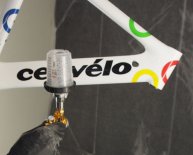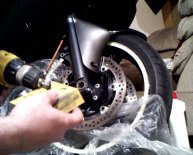
Airbrush texture Stencils
What the heck is dual-mode stenciling, you ask?! (So sorry - it’s the former engineer in me who loves to make up pseudo-scientific names to explain cookie decorating techniques!) Anywho . . . it’s a term I coined (I think) to indicate multiple, layered stenciled patterns made with two different stenciling media, such as airbrush coloring for an underlayer and Royal Icing for a top layer, as in the mod monogram cookies pictured to the right. I love the added depth that this technique affords; plus, stenciling is such a speedy way to add lush detail and texture to cookies. Read on to learn exactly how I applied this technique to these cookies. Or check out the related video on my YouTube channel.
What you’ll need:
- Parchment paper and backdrop, to protect your work area from food coloring!
- Metal trussing needle or toothpick, as needed
- Enough to stencil and otherwise detail the topcoated cookies
- Liqua-gel (aka soft gel) food coloring of your choice (darker colors are usually better for dual-mode stenciling)
- Water, for thinning icing, as needed
- Powdered sugar, for thickening icing, as needed
- Small offset spatula (about 3/4 x 3 1/4-inch blade)
- Parchment paper pastry cones (or substitute disposable plastic piping bags or pastry bags fitted with round tips)
Method:
1 | Get your cookies ready to go. Make sure the top coats on your cookies are dry all the way through, as you’ll be applying pressure to them in Steps 3 and 4, and smooshing top coats is generally not a good thing! To be on the safe side, I usually dry top coats overnight, if not longer.
2 | Prepare to airbrush the underlayer. First, take cover! By this, I mean cover your work surface with parchment paper and also set up a “surround” to capture any airbrush coloring that goes airborne (and, believe me, it will)! To keep my kitchen color-free, I use a foam-core, tri-fold backdrop (see third and fourth photos) that I picked up at Michaels.
Also, if you’re new to the airbrush, be sure to follow the manufacturer’s instructions to rig the filters and connectors properly; then practice airbrushing on paper before you ever touch a cookie. It’s wise to get a feel for how the coloring flows at various speeds and distances from your work surface. (If you don’t have an airbrush and don’t want to make the investment, then you can also use spray coloring for this step, though I find that many spray colorings don’t cover the cookie as uniformly and/or bead up when they hit a smooth cookie top coat.)
3 | Now airbrush the underlayer. Place your first stencil (for the background pattern) on top of a cookie. It’s critical that your stencil lie as flat as possible on the cookie surface; otherwise, coloring can easily sneak under it into areas you don’t want, leaving you with a fuzzy pattern. I prefer to use the tip of a trussing needle (aka turkey lacer) to hold the stencil flush against the cookie surface. A toothpick or your fingers will also do, though you’re more likely to airbrush yourself (!) with either of these approaches since your hand will be closer to the cookie. It was hard to photograph myself while holding the turkey lacer and airbrushing, but my video shows my stencil steadying approach quite well - if I do say so myself. :)
I also find that I get the crispest stencil when I hold the airbrush nozzle as perpendicular to the cookie surface as possible, set the flow to medium speed, and use broad circular motions of my hand to apply the color (rather than directing the color into a particular cookie area at a time). Be careful, however, about holding the airbrush too nozzle-down. If the receptacle is full to the top with coloring, you run the risk of pouring coloring onto your cookie. Again, if in doubt about your airbrushing technique, test the stencil on paper first.
Once you’ve covered the stencil evenly with color, to the desired hue, carefully peel away the stencil (i.e., “roll” it off one side of the cookie) to reveal the pattern. Allow the airbrush coloring to dry to the touch before adding the next icing layer. Airbrush coloring dries very fast, so it will likely be a matter of minutes before you can move onto the next step.
A few added side notes:
- Remember, the longer you spray, the darker, more saturated the end hue.
- Some amount of underspray (airbrush coloring that sneaks under the stencil around the cookie edges; see fifth photo) is inevitable unless you mask off the edges of the cookie or stencil with tape. If masking is too much work for you, but you don’t like the look of underspray, then work with a dark dough. As you can also see in the fifth photo, the underspray is virtually imperceptible on the gingerbread cookie; not so on the sugar cookie, however.
- The same coloring does not look the same on all cookies. Airbrush coloring can interact with the underlying topcoat, even if the latter is completely dry, and change hue. I think you’ll see what I mean in the sixth photo, where pink sprayed on a blue topcoat looks more purple than pink.
4 | Stencil the icing layer. First, tint your icing. I recommend mixing a color that is darker than the underlying airbrush color to ensure that no airbrush coloring peeks through the stenciled icing on top. Next, thin your icing to stenciling consistency, which is fairly thick. (I like the icing to have body and to cling to the end of an offset spatula without falling off; see seventh photo.)














